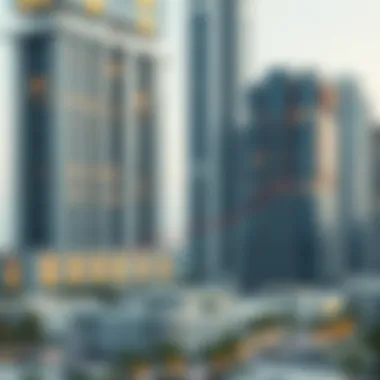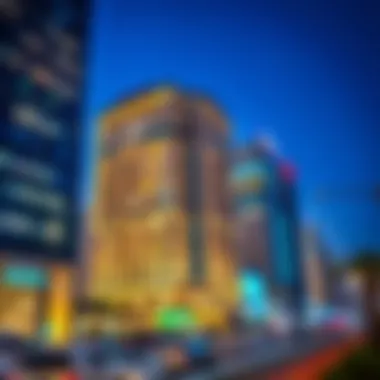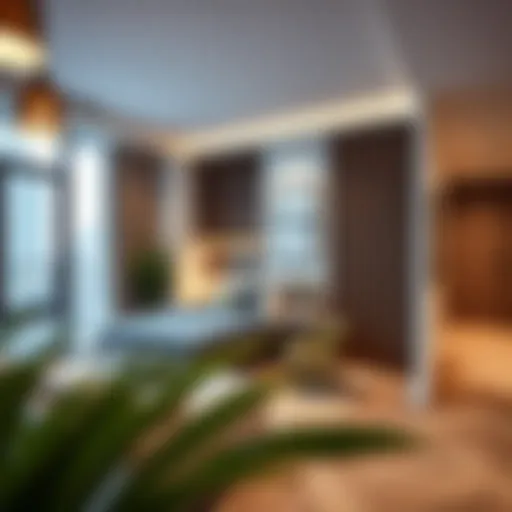Dirham Building: Impact on Dubai's Real Estate Market


Intro
In the bustling heart of Dubai, the concept of dirham building emerges as a crucial theme within the city’s sprawling real estate market. Here, the UAE dirham, firmly anchored to the US dollar, plays a foundational role, shaping not only the economy but also the dynamics of property development. Investors, property managers, realtors, and developers closely monitor this interplay, eager to capitalize on strategies that arise from the unique nature of currency valuation.
While the skyline dazzles with architectural wonders, understanding the significance of dirham building is essential for navigating today's investment landscape. In this exploration, we’ll dissect market trends, historical performance, and potential strategies that can ensure informed decision-making amid the intricate layers of Dubai’s real estate.
Market Overview
Current Trends in Dubai Real Estate
The real estate scene in Dubai is akin to a living organism, ever-evolving in response to economic shifts, regulatory changes, and global events. As of late 2023, a surge in foreign investment marks the current trends; high-net-worth individuals from around the world are looking towards Dubai as a stable sanctuary for their capital. The meticulous pegging of the dirham to the US dollar provides a sense of security, reassuring investors amidst fluctuating global markets.
Moreover, recent government initiatives aimed at diversifying the economy have spurred developments that cater specifically to luxury markets and sustainable living. This includes the rise of eco-friendly residential complexes and integrated community setups that blend work and leisure, enticing both local and expatriate buyers. The emphasis on quality and sustainability attracts a demographic keen on both investment potential and lifestyle offerings.
Historical Market Performance
Historically, Dubai's real estate market has seen its share of boom and bust cycles, each deeply intertwined with external economic factors. From the peak during the global financial crisis in 2008 to the slow recovery in subsequent years, the market has shown resilience. The dirham's stability has played a crucial role in keeping property prices relatively predictable, providing a sense of normalcy in turbulent times.
In analyzing market performance, we can observe that certain areas, like Downtown Dubai and Dubai Marina, have consistently outperformed others. These locations not only benefit from their prime positions but have also gained popularity due to effective marketing strategies highlighting their luxurious amenities.
"Buying property in Dubai is not just a financial transaction; it's an investment in a lifestyle that merges modernity with tradition."
As we traverse the discussion ahead, the dirham's influence on investment strategies will come into clearer focus.
Investment Strategies
Long-term vs Short-term Investments
When considering investment opportunities within the realm of dirham building, an important decision arises: should one adopt a long-term or short-term perspective? While short-term gains can be enticing, especially in a booming market, the stability of real estate investments tied to the dirham typically favors long-term hold strategies. Long-term investments can lead to greater capital appreciation over time, particularly as infrastructure and accessibility improve in emerging districts.
Identifying Emerging Areas for Investment
With Dubai's rapid urban expansion, spotting emerging areas is key for savvy investors. Neighborhoods like Al Furjan and Dubai South are gradually becoming hotspots, thanks to ongoing infrastructure projects and government-backed developments. These regions offer attractive entry prices, positioned conveniently for potential growth as the city continues to flourish.
In this landscape of opportunity, keeping abreast of local regulations, investment laws, and economic policies is paramount. Tools such as the Dubai Land Department and real estate forums on platforms like Reddit provide valuable insights for both novice and seasoned investors alike.
Understanding the duality of the dirham's value and the broader market trends in Dubai equips real estate stakeholders with the knowledge needed to make informed choices, ultimately shaping the emirate's landscape for years to come.
Understanding Dirham Building
The concept of Dirham Building plays a pivotal role in understanding the dynamics of Dubai's booming real estate sector. As Dubai continues to carve its place on the global stage, the significance of the dirham—a currency that serves as a foundation for many transactions—cannot be overstated. It stands as a symbol not only of the monetary transactions involved in real estate but also of the larger economic climate that encourages investments and development in the emirate.
When we define Dirham Building, we are diving into a specific practice that integrates the valuation and usage of the dirham into construction and property management strategies. This concept holds particular weight when assessing the feasibility and potential returns of investment properties. The dirham influences pricing structures, lending rates, and market accessibility, making it essential knowledge for investors, property managers, and developers who seek to navigate this landscape effectively.
Defining Dirham Building
Dirham Building encompasses much more than merely the act of erecting structures within the emirate. At its core, it represents a philosophy that emphasizes understanding how local currency shapes the real estate market. In brief, it refers to:
- The consideration of the dirham's stability and value in property pricing.
- A strategic approach to budgeting and financing construction projects in line with currency fluctuations.
- An understanding of consumer purchasing power woven into the fabric of property transactions.
When one thinks about the vast skyline of Dubai, filled with skyscrapers and luxurious properties, it’s vital to recognize how each of these structures is influenced by the economic principles surrounding the dirham. It is an examination of how currency affects market sentiment, not just a simple formulation of transactions. Each investment decision is intricately linked with the current state of the dirham, leading to varying opportunities for profits or challenges in the buying/selling processes.
Historical Context of the Dirham
To appreciate the intricacies of Dirham Building today, one must delve into the historical context of the dirham itself. The dirham has its roots in a rich history, tracing back to ancient trade routes that flourished long before modern Dubai emerged as a jewel in the desert. Its adoption and adaptations reflect the evolving economic landscape of the region. Specifically:
- The dirham was initially a silver coin used in trade and gradually transformed into a modern currency.
- Its peg to the US dollar, established in 1997, has led to a stable exchange rate that promotes confidence among both domestic and international investors.
- The currency has undergone various adjustments due to economic conditions, influencing everything from tourism to real estate.
This historical journey highlights how the dirham has been a consistent part of Dubai’s evolution. It isn't just a means of exchange; it is a reflection of stability and growth, which now plays an essential role in shaping policies and practices within the real estate market. The understanding of these factors can ultimately guide investment strategies and development plans, making it indispensable for stakeholders aiming to thrive in this competitive arena.
Understanding the dirham's historical significance helps investors align their strategies with both current market conditions and future projections, ensuring informed decision-making.


In essence, a thorough comprehension of Dirham Building not only illuminates the past but also informs the future, providing key insights for success in Dubai's ever-evolving property landscape.
Economic Implications
Understanding the economic implications of dirham building is crucial for anyone involved in Dubai's real estate market. The intertwining of currency valuation and property development shapes investment strategies, financing options, and ultimately, the stability of the market. With the dirham firmly pegged to the US dollar, this aspect introduces a unique set of advantages and challenges for investors and developers alike.
The Dirham's Peg to the US Dollar
The peg between the UAE dirham and the US dollar has been in place since 1997. This arrangement creates a stable economic environment, which is particularly attractive for foreign investors looking at Dubai's burgeoning real estate sector. The stability of the dirham against the dollar means that investment in Dubai properties can be viewed as a sound decision, minimizing exchange rate risk that often plagues investments in other currencies.
However, this system is not without its challenges. When the US dollar strengthens, the dirham follows suit, which can make Dubai real estate pricier for buyers from countries with weaker currencies. Thus, while some benefit from the stability, others might find the market becoming less accessible.
It's essential for investors to keep a close watch on global economic conditions. Fluctuations in the US economy can lead to shifts in the local market, prompting a need for careful financial strategy by real estate stakeholders. For developers, planning projects now must account for potential changes in currency dynamics, impacting the cost of materials and labor sourced globally.
Currency Valuation and Real Estate
Currency valuation plays a pivotal role in real estate investment. The dirham's value influences purchase power and investment desirability. For example, when the dirham retains its strong footing against international currencies, it boosts confidence among potential buyers, inviting them to invest in promising projects like luxury apartments or commercial spaces.
Additionally, investors from abroad frequently evaluate the health of a currency before committing funds. With a sound currency, properties might see higher returns and occupancy rates. It's a vicious cycle: a robust dirham may draw more international interest, which in turn boosts local demand and drives up prices further.
Still, it’s wise to practice caution. An overvalued currency can slow down new investments. In this situation, developers might reconsider timelines or adjust project scopes, ensuring that they do not outstretch their financial capabilities.
"Whether you're a seasoned investor or a newcomer, understanding the role of currency valuation in the real estate ecosystem is like having the keys to the kingdom."
In summary, the dirham's positioning against the US dollar not only sets the tone for the stability of investments but also creates a direct ripple effect on economic conditions impacting real estate growth. Recognizing these nuances can empower investors and property managers to make informed decisions in a competitive landscape.
Investment Strategies in a Dirham-Dominated Market
In the ever-evolving world of Dubai's real estate, investing wisely becomes paramount, especially in a dirham-dominated market. Understanding investment strategies tailored around the dirham is crucial for not just seasoned investors, but also newcomers looking to tap into this lucrative market. Various factors shape the investment landscape, from economic policies to market trends, influencing how one approaches property purchases and developments. Evaluating such strategies can offer significant benefits and considerations for potential and existing investors alike.
Assessing Market Trends
To get ahead in the property game, it is essential to assess the current market trends. This involves keeping an eye on the fluctuations of the dirham and its influence over real estate prices. Since the dirham is pegged to the US dollar, its stability allows investors to make more predictable decisions. Nonetheless, one must remain vigilant about external factors that could disrupt this balance, such as global oil prices or geopolitical tensions, which can indirectly sway market conditions.
Tracking ongoing infrastructure projects in Dubai also helps determine where the market is heading. Investment in key sectors—such as tourism and technology—can spark a chain reaction, leading to increased demand for housing and commercial spaces. A wise investor pays close attention to areas earmarked for future growth, like the sprawling developments around the Expo 2020 site, which have seen a surge in investment due to government initiatives and an influx of international visitors.
"In the realm of investment, knowledge is as valuable as currency itself."
Investors should utilize tools like data analytics and real-estate dashboards to obtain real-time insights. Networking with local agents and attending property expos can also provide valuable firsthand information about emerging neighborhoods and potential hotspots.
Identifying Investment Opportunities
Once market trends are assessed, the next logical step is identifying lucrative investment opportunities. In a dirham-oriented economy, recognizing niches within the market can yield impressive returns. For instance, focusing on residential developments aims to serve the rapidly growing expatriate community in Dubai. This demographic typically seeks rental properties, presenting an attractive avenue for investors who can satisfy this demand.
Moreover, commercial real estate can also be a goldmine. The increasing number of start-ups and entrepreneurs in the UAE signifies a need for office spaces and co-working environments. Investors can capitalize on this by purchasing or leasing properties that cater to these businesses.
Real estate investment trusts (REITs) also present an interesting option. By investing in publicly traded REITs in Dubai that focus on generating returns through property holdings, individuals can diversify their portfolios with less direct management risk. Plus, the added flexibility of being able to buy and sell shares offers an attractive aspect to many investors.
In summary, understanding investment strategies in a dirham-dominated market is essential to thrive within Dubai's dynamic real estate landscape. By actively assessing market trends and identifying opportunities, one can navigate this vibrant market with confidence. Investors are always on the lookout for the next big thing; thus, a proactive approach combined with insightful research will yield a fruitful outcome.
Development Practices Aligned with the Dirham
In the context of Dubai's dynamic real estate scene, development practices reflect the unique characteristics of the dirham. Given that the dirham serves as a robust currency, it plays a vital role in shaping not only project funding but also the overall market landscape. Each dirham spent carries weight, making it crucial for developers, investors, and stakeholders to align their strategies with this currency's realities and strengths.
Funding Mechanisms for Dirham Projects
Understanding how funds flow into dirham-based projects is fundamental for stakeholders. Financial institutions, both local and international, have tailored funding options that accommodate the intricacies of the dirham. This adaptability stems from various funding methodologies such as:
- Bank Loans: Most developers often seek loans from banks that operate within the UAE. These loans typically feature favorable terms aligned with the dirham,
- Public-Private Partnerships (PPPs): Collaborations between the government and private entities help in pooling resources for major projects. Given the reliable backing of the dirham, PPPs can attract sizable investments,
- Real Estate Investment Trusts (REITs): With the dirham as the funding currency, these structures can yield higher returns in the market by offering investors a share of property income without needing to outright own real estate.
Such methodologies provide multiple avenues for financing, helping projects get off the ground while ensuring sustainability.


Cost Considerations in Dirham Building
When embarking on a construction project, developers must bear in mind the costs associated with the dirham. This currency's stability strongly impacts project budgets, mitigations of risks, and profit projections. Economic factors such as:
- Material Costs: Many construction materials must be imported, and fluctuating global prices can impact spending almost immediately. Hence, negotiating fixed rates in dirhams prevents unexpected expenses.
- Labor Costs: The labor market in Dubai, particularly in construction, is dynamic and sometimes unpredictable. Thus, cost analyses should account not only for current wages but also consider potential increases over the project timeline.
- Permitting and Regulations: The legal landscape surrounding construction permits can vary; hence, there's the need for clear projections of possible costs for obtaining approvals from local government bodies.
These considerations are crucial, as the last thing a developer wants is to find themselves in a precarious financial position when building in a dirham-driven environment.
"A clear alignment with the dirham within development practices not only safeguards investments but also reinforces developer reputations in the ever-evolving Dubai real estate landscape."
Each of these aspects must align seamlessly to create successful projects that resonate with the expectations of various stakeholders involved in Dubai’s ever-expanding real estate market.
Regulatory Framework and Its Impact
The regulatory framework governing real estate in Dubai plays a pivotal role in shaping the landscape of dirham building. This framework encompasses a variety of factors, including government regulations, policies, and legal considerations that impact both the construction processes and the market dynamics. A well-structured regulatory environment not only facilitates smoother transactions but also encourages foreign investment and promotes sustainable growth. As a result, understanding the nuances of these regulations is essential for stakeholders such as investors, developers, and property managers.
Government Policies Affecting Real Estate
Government policies are at the heart of Dubai's real estate sector, influencing everything from property ownership rights to zoning laws. The real estate market in Dubai has been significantly shaped by various initiatives and regulations established by the Dubai Land Department and other governmental bodies. These policies aim to stabilize the market, enhance transparency, and boost investor confidence.
For instance, the introduction of long-term visas for foreign investors and expats has attracted a considerable influx of talent and capital. Such policies have created a vibrant market where dirham building is flourishing. Also, the regulations concerning ownership rights, especially for expatriates, have broadened opportunities for investment. Below are some key government policies that have notably affected real estate in Dubai:
- Ownership Laws: These laws dictate who can own property in Dubai and what types of properties are permissible for foreign investors.
- Investment Incentives: The government frequently introduces initiatives aimed at encouraging foreign capital by providing tax benefits and easing the process of property acquisition.
- Market Regulation: Policies that enhance transparency, such as the implementation of escrow accounts for off-plan projects, help to build trust in the market.
"Government policies can be like a double-edged sword: when implemented thoughtfully, they can incentivize growth and stability across sectors, particularly in real estate."
Legal Aspects in Dirham Building
Legal considerations are another crucial element in the dirham building landscape. The legal framework encompasses various aspects, including contract laws, property development regulations, and compliance with local laws. Understanding these legal elements is vital for anyone involved in property investment or development.
One major aspect is the contractual obligations between developers and investors. Contracts in the real estate sector need to be clear and comprehensive to avoid disputes. Additionally, compliance with the Building Code and other related regulations ensures that construction practices meet safety standards and sustainability targets. Legal matters around finance, such as obtaining mortgages and adhering to the financial regulations by the Central Bank of the UAE, are crucial too.
Moreover, legal due diligence is important for investors looking to ensure their funds are safeguarded against potential pitfalls. Engaging legal experts familiar with the specifics of the Dubai market can provide invaluable support in navigating complexities associated with property acquisition and investment.
In summary, the regulatory framework — covering government policies and legal aspects — forms the backbone of the dirham building sector in Dubai. Navigating this intricate landscape is critical for anyone looking to invest or operate within the Emirate's ever-evolving real estate market. To delve deeper into the specifics of Dubai's real estate laws and regulations, you can access resources from Dubai Land Department and UAE Government Portal.
Challenges in Dirham Building
In the context of Dubai's bustling real estate scene, understanding the challenges in dirham building is of utmost importance. These hurdles can significantly shape the trajectory of the market and influence investment decisions. Notably, market volatility and supply chain issues are critical challenges that require careful consideration.
Market Volatility and Its Effects
Market volatility is like a roller coaster ride where investors sometimes find themselves gripping the safety bar with both hands. The fluctuations in property prices can lead to both excitement and trepidation, making it imperative for investors to be vigilant.
When the market experiences rapid changes, it can affect property values, financing options, and overall investor confidence. As the economic landscape shifts, driven by factors such as global economic trends and local developments, property values in Dubai don’t remain static.
For instance, during a downturn, property prices may dip, creating an attractive entry point for some investors while simultaneously striking fear into the hearts of others who might hesitate to invest. Such volatility often forces investors and developers to reassess their strategies frequently.
"In real estate, timing and adaptability are just as crucial as location."
Furthermore, economic factors such as supply-demand dynamics, interest rates, and tourism trends contribute to the unevenness of the market. With the dirham pegged to the US dollar, geopolitical issues could additionally create ripples across the market. Investors must be well aware of these fluctuations to make informed decisions, forecasting and adjusting their plans accordingly.
Supply Chain Issues in Construction
Another significant challenge in the realm of dirham building are supply chain issues in construction. These problems can stem from delays in material delivery, skilled labor shortages, and even regulatory changes that can halt or slow down construction projects. Such hurdles can lead to project overruns, which invariably affect the bottom line for developers.
In Dubai, where construction is often rapid and expansive, any hiccups in material supply can pose substantial risks. For example, if concrete or steel is delayed, it can push back timelines, often leading to increased costs. This makes budgeting nearly an art—balancing the books while navigating unpredictable external factors.
Additionally, with many developers relying on imported materials, global trade dynamics play a vital role in the supply chain's health. Fluctuating freight costs and changing tariffs can impact the cost structure of a project significantly, further complicating financial forecasting.
- Local workmanship: Developing talent locally can help mitigate labor shortages.
- Sustainable materials: Sourcing materials locally not only reduces dependency on imports but also promotes sustainability.
- Strong partnerships: Building relationships with suppliers and contractors can ease the burden of delays.


Sustainable Practices in Dirham Building
Sustainability in real estate is no longer just a catchphrase. In Dubai, where rapid development has led to breathtaking skylines and sprawling communities, the shift towards sustainable practices is imperative. The concept of dirham building encompasses not just the construction of properties but also how they impact the environment and society. Integrating sustainable practices into dirham building is essential for several reasons, revolving around environmental stewardship, economic efficiency, and social responsibility.
A few key benefits of adopting sustainable practices in dirham building include:
- Reduced Operational Costs: Sustainable buildings often result in lower utility expenses, thereby increasing the profitability of investments.
- Enhanced Property Value: Eco-friendly properties tend to retain their value better, making them attractive to investors.
- Regulatory Compliance: As regulations tighten concerning building practices and environmental impacts, adhering to sustainable practices helps developers remain compliant and avoid penalties.
Incorporating sustainability is not merely beneficial; it has become a competitive edge that developers need to leverage. As more investors prioritize green credentials, projects that demonstrate environmental awareness through sustainable practices can capture a larger share of the market.
Integrating Sustainability into Development
Integrating sustainability into the construction process involves various principles that touch on materials, energy consumption, and community engagement. One of the primary ways this can be achieved is by utilizing locally sourced materials which drastically reduces transportation emissions. Additionally, opting for materials with a high recycled content minimizes the environmental footprint associated with new resource extraction.
Energy efficiency is also a vital consideration. Developers can incorporate technologies such as smart building systems, which optimize energy use based on occupant behavior. These systems can lead to significant reductions in energy consumption and operational costs. Moreover, designing spaces that maximize natural light can either cut costs or enhance the living experience, creating a win-win scenario.
Furthermore, community involvement in the planning phase can lead to development that resonates more with potential occupants. Involving local stakeholders ensures that projects cater to the actual needs of the community, making the developments more sustainable in a social context as well.
The Role of Renewable Energy in Construction
Renewable energy plays a transformative role in changing the dynamics of dirham building. The integration of solar panels, wind turbines, and geothermal systems can significantly decrease reliance on fossil fuels, leading to a greener construction phase and sustainable living.
For instance, many new developments in Dubai are beginning to incorporate photovoltaic solar panels into their designs. These installations not only provide clean energy but may also yield financial incentives through government programs encouraging solar energy deployment.
Moreover, building designs that allow for the capture and reuse of rainwater can significantly alleviate the pressure on municipal water systems, creating self-sustaining ecosystems within properties. Implementing such practices not only enhances the environmental appeal of projects but further positions them as foresighted investments.
"The path to sustainability is not a sprint but a marathon. Integrating renewable energy and promoting sustainability is essential for long-term success in Dubai's real estate market."
Future Trends in Dirham Building
The real estate landscape in Dubai is continually shifting, influenced by various factors including economic policy, technology, and shifting consumer preferences. Understanding the future trends in dirham building is crucial for investors, developers, and all stakeholders involved. With the dirham as a cornerstone of Dubai's property market, anything that affects its viability directly impacts investment strategies and project financing. The trend towards sustainable and innovative construction practices represents a pivotal area of focus. As the world leans into more eco-friendly solutions, the dirham will play a key role in shaping these developments.
Key considerations surrounding future trends include:
- Sustainability: More developers are leaning towards eco-conscious designs that integrate renewable materials, which often come with lower long-term costs.
- Technological Integration: Adoption of technology is burgeoning, notably through smart building systems which enhance efficiency and reduce operational costs.
- Market Adaptability: Trends show a need for properties that cater to evolving demographics. This calls for flexible spaces that can be repurposed for various uses.
Technological Innovations in Real Estate
In the realm of dirham building, technological innovations are not just a fad; they’re becoming a standard. With rapid advancements in construction technology, including building information modeling (BIM) and 3D printing, real estate developers in Dubai are finding new avenues to save time and cut costs. These innovations help deliver projects faster and with better precision than traditional methods.
- BIM allows for a detailed visual representation of projects that helps in detecting clashes in designs before construction even begins, reducing the chances of delays and additional costs.
- 3D printing of building materials and even entire homes is on the rise. This method not only decreases labor costs but also promotes sustainability by minimizing waste.
Investors should also keep an eye on smart home technology; integrating IoT (Internet of Things) solutions into buildings provides a significant selling point. Features that allow residents to control lighting, air conditioning, and security systems from their mobile devices are no longer luxuries but rather expected norms.
Forecasting the Dubai Real Estate Market
Looking ahead, forecasting the Dubai real estate market can be a tricky endeavor, lakini it's essential for stakeholders to remain informed. Economic shifts, changes in the global market, and ongoing geopolitical dynamics can all influence property values and investment potential.
Several factors merit attention:
- Supply and Demand: Analyzing the current inventory of properties versus buyer interest offers insights into future market conditions. As more people flock to Dubai for work and lifestyle, demand for housing continues to surge.
- Interest Rates: Keep a close watch on central bank policies, especially regarding interest rates. The dirham’s pegged relationship to the US dollar means fluctuations can affect borrowing costs in real estate.
- Government Initiatives: Policies such as Dubai's Expo 2020 and other mega-projects serve as bellwethers for investment trends. Government incentives aimed at foreign investment can stimulate growth in various segments of the market.
Ultimately, understanding these trends and adapting to them can set real estate stakeholders apart from their competitors. The ability to foresee changes in the dirham building sector can significantly impact decision-making strategies moving forward.
To gain deeper insights into the dynamics of the Dubai property market, consider exploring resources like the Dubai Land Department's website or reputable financial news platforms on real estate.
Ending
Understanding the significance of dirham building is crucial in navigating the intricate landscape of Dubai's real estate sector. This article dissected the multifaceted nature of dirham building, shed light on economic implications, and examined investment strategies tailored specifically for this market. Each layer of discussion brought forth valuable insights that resonate with various stakeholders, including investors, property managers, realtors, developers, and expats.
Recap of Key Points
- Definition and significance: Dirham building is not just about currency; it reflects a broader economic framework that affects property development and investment decisions in Dubai.
- Economic implications: The dirham's peg to the US dollar plays a crucial role in shaping the real estate market, influencing price stability and attracting foreign investments.
- Investment strategies: Identifying opportunities in a dirham-dominated environment requires astute understanding of market trends and individual property valuations, maximizing potential returns.
- Regulatory impacts: Government policies and legal frameworks significantly affect dirham building, providing both challenges and safeguards for investors.
- Sustainability trends: Incorporating sustainable practices into building processes is increasingly recognized as a competitive advantage in Dubai's ambitious real estate environment.
Final Thoughts on Dirham Building
As the saying goes, "knowledge is power," and in the context of dirham building, informed decisions can significantly alter outcomes. Investors should remain keen observers of market movements and regulatory changes to thrive in this vibrant and ever-changing sector. For relevant insights, references, and continuing discussions about Dubai's real estate, consider visiting Wikipedia, Britannica, and platforms like Reddit for real-time community engagement.



